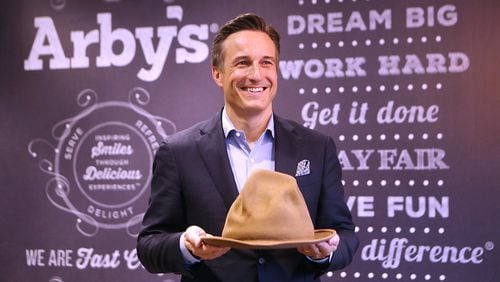When Paul Brown was named chief executive at Arby’s in 2013, the Atlanta fast food chain was just beginning to recover from a years-long slide that had left it a punchline on The Daily Show.
Brown, a Cobb County native who earned his stripes in the hotel, airline and travel industries, might not have seemed an obvious choice for revving up the 52-year-old roast beef sandwich chain.
But under Brown, Arby’s has shot out of the chutes like a bull that didn’t want to end up on the menu. Brown, 49, pushed Arby’s to revamp its marketing and to roll out new and exotic meals at a much faster pace, including things like venison and Kentucky bourbon-flavored bacon sandwiches.
Since then, the company’s market share, revenues and industry ranking have jumped. The results have won Brown recognition, including an Ernst and Young Entrepreneur of the Year award this year for the Southeast, and a Golden Chain Award from Nation’s Restaurant News.
The AJC recently talked to Brown about re-tooling the chain. His comments are edited for clarity and length:
Q: You came from Northwest Airlines, Expedia, Hilton, InterContinental Hotels, McKinsey & Co. How did that help with Arby’s?
A: The restaurant industry looks a lot like retail and hospitality. You have multiple locations. There are owner-operators but also a lot of franchisees involved. Real estate. Architecture. All of that looks quite similar in many ways.
Q: What’s a big difference?
A: The pace of product development, if you’re going to do it right, is incredibly fast … We’re coming out with a new advertising campaign and a new product every single month. The way you stay at the top of customers’ minds is by coming out with new great products… and putting some really compelling advertising around it.
Q: How does changing up the food items help?
A: I think it is a key reason Arby’s has seen success beyond what others have seen. It keeps us top of mind, fresh, interesting.
We have made the menu more interesting by diversifying around roast beef. Arby’s was very tightly defined as a brand around roast beef….If you look at our new products we’ve launched, virtually none of them have been roast beef. They’ve been other proteins, and that has been appealing to a broader base of customers.
The second thing that we’ve done is launch sliders. Sliders (small sandwiches) are an affordable entry-level price point. We price them at $1.29 apiece (to bring in younger customers).
That’s the product side. If you go to the marketing side, there’s a lot of things we have done to reach a much younger audience.
Q: Like what?
A: The ‘We have the meats’ campaign, I think that has pretty broad appeal. It appeals to people my age, but it also has a lot of appeal to teenagers and the younger children. I think it just gets people’s attention.
But where I think we’ve made the greatest strides really is in social media and PR. Some of the things that we’ve done around (pop singer) Pharrell (Williams’) hat, e-leagues, e-gaming. Those types of things really, really appeal to a younger audience.
Q: You mean like how Arby’s had a “spat” with former (Daily Show host Jon Stewart, who frequently made fun of Arby’s food on the show?)
A: When the Jon Stewart thing came up, (we) could have taken a path of being very corporate and getting very defensive about it, and getting the lawyers involved to try to get him to stop. Or (we) could accept the fact that it’s actually fun….So we just decided to be authentic. We are Arby’s. Let’s just have fun with Jon. Serve him food and write letters to him and offer him a job when he decides to quit the Daily Show.
Q: And what was that about Pharrell’s hat?
A: You saw the hat out there, right? (He was referring to a floppy brown hat in a display case in Arby’s headquarters that somewhat resembles Arby’s cowboy hat logo.)
During the Grammys, (Pharrell Williams) came out wearing that hat. Our social media manager was watching the Grammys and started noticing on our Facebook page, a few people were saying, ‘What are you going to do about this? He’s wearing your hat.’ On Twitter there was all this conversation about this hat, how crazy it was.
So (Arby’s social media manager) Tweeted out, ‘Hey Pharrell, can we have our hat back?’ And it just went crazy. It was funny because it was Arby’s. Arby’s was so far from being associated with anything in the entertainment industry or trendy.
(After the Grammys, Arby’s bought the hat from Pharrell in a charity auction on eBay for $49,000.)
Q: Before all these sorts of moves, Arby’s had one of the oldest customer bases in the industry. Where is growth coming from now? New customers or existing customers?
A: It’s really about 50-50. In the past three years we’ve increased our transactions about 11 percent, which is in this industry doesn’t happen very often. Of that 11 percent increase in traffic, about 50 percent of that is increased frequency of customers who were coming to us before, and about half is customers who weren’t coming to us.
Q: Who are your core customers?
A: I think that’s one of our keys to success. We started by defining our customers by psychographics – what their value systems, their belief systems, are. And then you can figure from that, where they are. I think a big mistake a lot of (businesses) make is they go straight to demographics (like age, income and education level.)
Q: Please explain…
A: We have four core psychographic segments. We have fun labels for them.
The first one is the ‘fast foodies.’ These are people that like the new, new thing … They don’t like to eat the same thing they ate last month.
I should add we (pay attention to) household income. The average consumer for Arby’s has a $55,000-a-year (household income.)
The second segment, we call them ‘eating machines.’ They are protein junkies….Younger, active (people) … and construction workers and people like that who look at food as fuel.
The third one would be families whose parents are from the first two segments who are bringing children with them, where affordability matters a lot.
The last segment is ‘American traditionalists.’ That’s where a lot of our previous core customers are, who probably grew up eating Arby’s.
It (psychographics) works, because the problem in an industry as big as ours, everybody eats fast food. If you start with demographics, then all the sudden (the core customer) looks like the average American, and if all you’re trying to do is appeal to the average American, then everything you do just kind of looks average.
Arby’s at a glance
Headquarters: Sandy Springs
History: Founded in 1964. Moved to metro Atlanta in 2005.
Ownership: Bought in 2011 by Roark Capital Group, an Atlanta private equity firm, for $430 million.
Employees: 400 at headquarters; 75,000 at company and franchise stores.
Revenues: $3.6 billion, up 29 percent from 2010.
Restaurants: 3,300, down 8 percent from 2010.
Revenue per restaurant: $1.1 million, up 41 percent from 2010.
Industry market ranking: 16th






